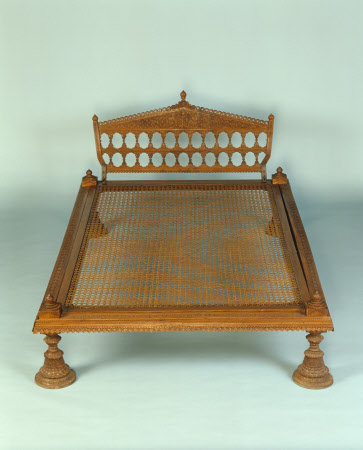Travelling bed
Category
Furniture
Date
1760 - 1800
Materials
Sandalwood and cane
Measurements
1920 mm (H); 1330 mm (W); 1775 mm (H); 1140 mm (W); 560 mm (H); 1120 mm (W); 450 mm (H); 1060 mm (H); 1710 mm (W); 390 mm (Dia); 430 mm (H); 380 mm (W)
Place of origin
India
Order this imageCollection
Powis Castle and Garden, Powys
NT 1180666
Summary
Carved sandal- and cedarwood travelling couch or throne, Mysuru, late 18th century.
Full description
This piece of furniture is easily to dismantle for travelling, with its detachable cedarwood headboard. It may have been used as a bed, throne or both in Mysuru. The low relief carving of floral and lotus motifs which border the sandalwood bedframe is typical of late-18th/19th-century woodwork from Mysuru. [Archer p. 80] Henrietta Clive, who acquired this item, believed that it had belonged to Tīpū Sultān, ruler of the state of Mysuru from 1782-99. There he built a sophisticated court around his palace at Srirangapatna (formerly known as Seringapatam). Research Note on Provenance: Henrietta Clive (1758–1830), later Countess of Powis, may have purchased or been given this furniture while in India with her husband Edward during his tenure as Governor of Madras. In a draft of her will dated 14 February 1825 Clive bequeathed to her eldest son 'The Sandal Wood bedstead and Quilt and Carpets that were Tipoo Sultans'. A ‘Sandal Wood bedstead’ is recorded in an 1801 inventory of Henrietta Clive’s possessions when she returned to England from India. [Archer p. 80] Tīpū Sultān (1750-99) was a powerful ruler whose reign was characterised by both military conflict and reform. During his 17-year reign, Tīpū introduced direct revenue collection, changes to land ownership, investment in agriculture and industrialisation, and social reforms. His rule also saw the establishment of factories and trading companies beyond Mysuru, and he supported the immigration of skilled foreign workers in order to develop local capability to produce modern firearms. [Satyanarayana, pp. 2445-7] Tīpū Sultān spent much of his reign engaged in the defence of Mysuru against encroachment by the British East India Company. In 1798, a renewed British campaign provoked the Fourth Anglo-Mysore War. On 4th May 1799, during the Siege of Srirangapatna, Tīpū was killed. In the immediate aftermath, the British army looted Srirangapatna. According to Colonel Arthur Wellesley, later the Duke of Wellington, ‘Scarcely a house in the town was left unplundered, and I understand that in camp jewels of the greatest value, bars of gold etc etc have been offered for sale in the bazaars of the army by our soldiers, sepoys and followers. I came in to take command of the army on the morning of the 5th and with the greatest exertion, by hanging, flogging etc etc in the course of that day I restored order…’ [Dalrymple, p. 359] The resumption of control by the higher ranks of the army enabled the work of the prize committee to begin. Prize committees were responsible for ‘collecting, inventorying and disposing of booty seized from the enemy and for compiling detailed lists of who had served under whom in each campaign – thereby seeking to establish combatants’ entitlement to prize'. [Finn, p. 17] They were intended to prevent exactly the kind of undisciplined plunder of captured cities and defeated people which Wellesley reported in the aftermath of Tīpū’s defeat at Srirangapatna. More than 1,000 commissioned officers took their allotted share in the captured property, which they kept, exchanged or sold to others. High-value, or high-profile items, were excluded from the prize committee’s remit, and given to senior British civil and military personnel, as well as the British royal family. [1] Not all articles were genuine: tenuous or spurious attributions to Tīpū Sultān have been identified in objects which were brought to Britain. [1] ‘Tipu Sultan’s Amulet Case’, accessed online at https://www.nms.ac.uk/explore-our-collections/stories/scottish-history-and-archaeology/tipu-sultan/tipu-sultan/tipu-sultans-amulet-case, 10/2/22.
Provenance
Taken following the death of Tīpū Sultān and the sack of Srirangapatna, 1799. Acquired by Henrietta Clive in India and recorded in 1801 inventory. Brought to Powis Castle from Walcot Hall in 1930. Accepted by HM Treasury on 21st March 1963 in lieu of tax and conveyed to National Trust ownership on 29th November 1963.
References
2019 Dalrymple: W Dalrymple, The Anarchy: The Relentless Rise of the East India Company, Bloomsbury 2019 2018 Finn: Margot Finn, ‘Material Turns in British History I: Loot’, Transactions of the Royal Historical Society, Vol. 28, December 2018 2004 Satyanarayana: A Satyanarayana ‘Review: The Mysore Sultans. State and Diplomacy under Tipu Sultan: Documents and Essays by Irfan Habib’ Economic and Political Weekly 39 24 (2004) Archer, Rowell and Skelton 1987 Mildred Archer, Christopher Rowell, and Robert Skelton, Treasures from India: The Clive Collection at Powis Castle, London, 1987
